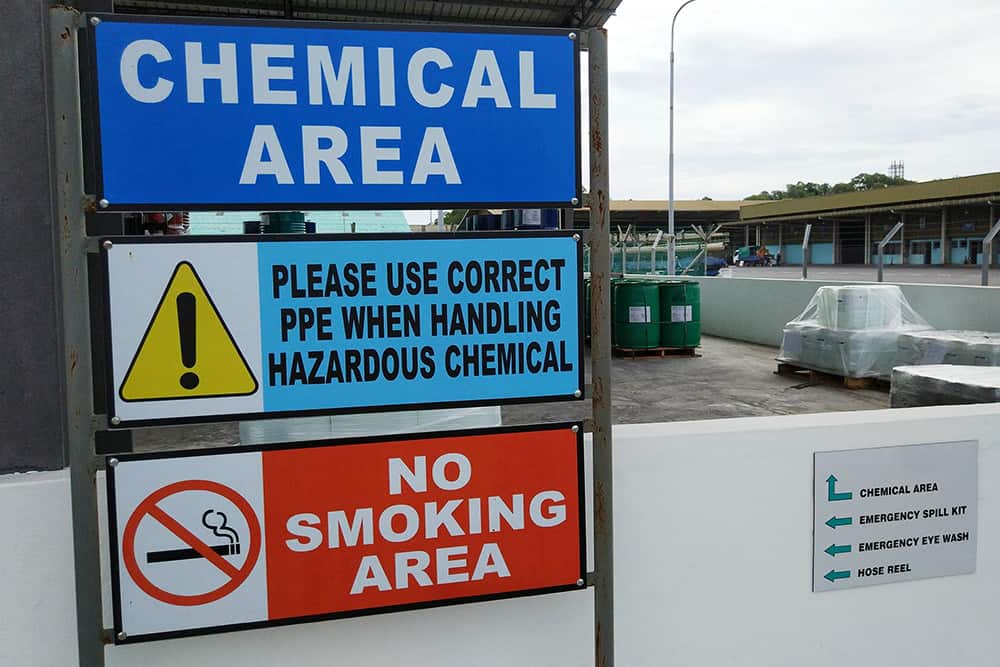
The risks associated with hazardous substances don’t just go away when the working day is over. Storing hazardous substances in anything other than the recommended manner can mean disaster. Fires, explosions, corrosive leaks, and spills of poisonous materials can all happen because of incorrectly stored hazardous substances.
Keeping your business safe requires you to keep all hazardous substances stored properly. Following the COSHH storage requirements will make sure that all hazardous substances in your place of business are stored safely. If you are not following the COSHH regulations, then not only are you putting your property and your people in danger, but you are also breaking the law. To help you protect your business and your employees, we’ve put together this guide on what you need to know about COSHH storage requirements.
The Importance of Following COSHH Storage Requirements
Avoiding accidents involving any kind of hazardous substance involves more than just good handling and working procedures. How you store hazardous products or chemicals is just as important as how you use them.
Many chemicals can become unstable if they are not kept in the correct containers at the correct temperature. Even while sitting on a shelf, some hazardous substances still pose significant safety risks.
Some chemicals or products can give off harmful fumes, gases, or vapour, so must be kept in airtight containers in properly ventilated rooms. Other substances can become explosive if kept at the wrong temperatures or if they come into contact with other chemicals. Gases kept in pressurised cylinders can explode if not kept at the correct temperature. Corrosive substances can leak and spill if not stored in appropriate containers.
Staying safe and complying with the law means following the guidelines as stipulated by the Control of Substances Hazardous to Health Regulations 2002 (COSHH).
Case Studies – What Can Happen If COSHH Regulations Are Not Followed
An explosion at International Paint in Gateshead, UK, in 2022 was found to have been the result of insufficient measures to control the risk of using flammable substances, as reported by the Health and Safety Executive (HSE).
One worker was seriously injured in the explosion. The HSE determined that failure to remove flammable vapours was one of the causes of the explosion. The company was fined £800,000 and made to pay £14,032 in court fees.
Rhodia Eco Services Ltd in Staveley was fined £100,000 and made to pay £19,902 in court costs when a chlorine leak caused six workers to be hospitalised in 2005. The company was found to be guilty of two breaches of health and safety legislation.
All business owners must make certain that they are operating in a way that is fully compliant with COSHH regulations. If you’re not running your business according to COSHH requirements, then you are risking the health and well-being of your team and the viability of your enterprise.
How to Store COSHH Substances Correctly
Correct storage methods must be followed for any substance that is categorised as being flammable, toxic, corrosive, poisonous, an irritant, or otherwise harmful according to COSHH regulations.
Store Minimum Amounts of Hazardous Substances
The COSHH regulations recommend that businesses should store only the minimum amount of a hazardous substance required to complete tasks. When any hazardous substance has been used for a task, it should be returned to the storage area immediately.
Only 50 litres of extremely flammable liquids or liquids with a flashpoint below the minimum ambient temperature of the working environment can be stored in cabinets or bins. Only 250 litres of flammable liquids with a flashpoint between 320°C and 550°C can be kept in designated areas.
Restrict Exposure and Access
COSHH storage requirements stipulate that hazardous substances must be stored in a way that minimises exposure and risk. There should be specific storage spaces for all COSHH substances. Access to these areas should be restricted to authorised personnel only and stringent security measures must be implemented. Security measures can include:
- Fencing
- Locking doors
- Welded metal mesh
- Security alarms
- Manned patrols
- Access control systems
- Lockable connection covers

Follow Instructions and Use Appropriate Containers
Hazardous substances should be kept in the original containers. If this is not possible, they must be stored in a clearly labelled container that is fit for purpose. Hazardous substances must never be kept in containers that have a dual purpose, for example, containers that can also be used for eating or drinking. Any storage instructions on the product or chemical’s safety data sheet (SDS) must be followed exactly.
Maintain Appropriate Temperatures and Ventilation
Hazardous substances must be kept at the correct temperature and shielded from the sun, heat, or any corrosive substances or ignition sources. Gas cylinders should be kept at temperatures less than 50°C, for example.
The storage area must have adequate ventilation. An LEV system should be installed if work processes involve the release of hazardous gases, vapours, or mists. If possible, storage facilities should be located in open-air environments.
In 2022, Airtec Filtration Ltd in St Helens, Merseyside, was fined £2,666 and had to pay court costs of £4,074. The company was charged with not providing satisfactory Through Examination and Tests (TExT) of local exhaust ventilation (LEV) systems. The company alleged that their work met COSHH standards, but this was proved to be not the case by the HSE.
Segregate Flammable and Hazardous Materials
Any chemicals that may react with each other must be kept separately at a distance of at least three metres. Acids and alkalis must be kept on separate shelves.
All flammable liquids must be stored in fire-resistant containers, bins, or COSHH cabinets. Any liquid that has a flashpoint between 320°C and 550°C must be stored in a fire-resistant COSSH cabinet.
Types of COSHH Cabinets
COSHH cabinets are designed to store hazardous substances such as chemicals, corrosives, and flammable liquids. COSHH cabinets are fireproof, leakproof, secure, reinforced, and built with specific safety features such as sumps for spillage.
There are four common types of COSHH cabinets:
- Yellow General COSHH Cabinets
- White COSHH Cabinets for Acids and Alkalis
- Ventilated Agrochemical and Pesticide COSHH Cabinets
- COSHH Cabinets for Flammable Substances
Be Sure Your Team Gets the Right COSHH Training
Storing COSHH substances incorrectly can result in serious accidents that cause injuries, ongoing health problems, property damage, or even death. Failing to implement COSHH storage requirements can leave you liable for significant fines and can even result in criminal charges being brought against you.
Protect your people and your business by enrolling in the Hazardous Substances courses from Human Focus. The Hazardous Substances courses will provide you with the knowledge you need to handle, use, and store hazardous substances safely and in full compliance with COSHH regulations.
You can sign up for a Human Focus course quickly and easily via their website. All courses can be completed online at your convenience and are fully accredited by recognised health and safety authorities. Discover the full range of Human Focus health and safety training solutions now!
































































































































































































































































































































































































































































































































































































































































































































































